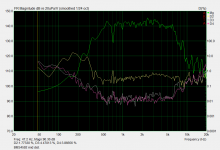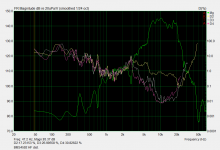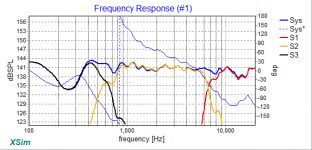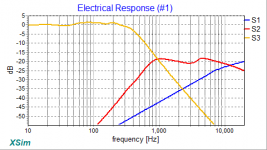Hi,
i like this one as well:

FaitalPRO | HF Drivers | HF1440
New FaitalPro HF1440 Compression Driver Extends Frequency Response and Power in a Compact Format | audioXpress
KR Barossi
i like this one as well:

FaitalPRO | HF Drivers | HF1440
New FaitalPro HF1440 Compression Driver Extends Frequency Response and Power in a Compact Format | audioXpress
KR Barossi
I didn't think we were certain that these were any good?
Martin Colloms is testing it.
I didn't think we were certain that these were any good? (Yet, please correct me if I'm wrong).now that the DCX464 has become available.
Edit: Sorry Ro, edited this post. and thanks for your reply.
No reason to buy any of the BMS coaxes, now that the DCX464 has become available.
If you must... buy them used because these are offered plenty from second, third or ....... owner.
Why would that be?
nothing against it just:
a) not many tests or use cases in DIY..
b) only 16ohm version at the moment. (my supplier seems to have the 16ohm available 1st Aug) I'd like an 8Ohm CD
EDIT: I found a pdf in Italian with the 8ohm version. the freq graphs+extension seem better on the BMS
Last edited:
It certainly seems like the future regardless of price.
what makes it SO better that the BMS??
EDIT: I found a pdf in Italian with the 8ohm version. the freq graphs+extension seem better on the BMS
I'd suggest to look at the aspects that really matter and cannot be fixed by the user.
I'd suggest to look at the aspects that really matter and cannot be fixed by the user.
elaborate a bit plz? (as the user is a bit dum 🙂 )
Last edited:
The DCX464 thread on this forum is one obvious source.
Quote:
Originally Posted by Joseph Crowe > about the BMS technology:
"The problem has always been with the co-entrant design where the high and mid frequencies have to combine somehow without causing the high frequency wavefront to encounter an abrupt physical change in the pathway curvature. Usually the high frequency sound wave has to "jump" a physical gap. This causes higher order harmonics to form which effects the performance of the driver in the time domain."
Bennett Prescott, B&C Sales & Operations Director – North America:
"We have mitigated this with our (patent pending) midrange filter, which makes the MF path look very high impedance to the HF driver and filters the higher response of the MF driver so it doesn't resonate in the HF cavity."
But I don't think Bennett tells the whole story. I believe the design of the DCX464 is also different from the BMS Coaxials.
Here I've posted a comparison of curves.
Quote:
Originally Posted by Joseph Crowe > about the BMS technology:
"The problem has always been with the co-entrant design where the high and mid frequencies have to combine somehow without causing the high frequency wavefront to encounter an abrupt physical change in the pathway curvature. Usually the high frequency sound wave has to "jump" a physical gap. This causes higher order harmonics to form which effects the performance of the driver in the time domain."
Bennett Prescott, B&C Sales & Operations Director – North America:
"We have mitigated this with our (patent pending) midrange filter, which makes the MF path look very high impedance to the HF driver and filters the higher response of the MF driver so it doesn't resonate in the HF cavity."
But I don't think Bennett tells the whole story. I believe the design of the DCX464 is also different from the BMS Coaxials.
Here I've posted a comparison of curves.
Last edited:
A translated quote from a pro audio guy on BMS:
"I have had the BMS 4592ND, it does not compare to the (JBL) 2482 in the low freq. spectrum by far ... (and in general distortion figures of BMS coax drivers are bad).
I have also tested the 4599 (double dome), here again the figures are wacky, do not even correspond to BMS' own measurements and the amount of distortion is huge."
This is just one of many similar comments on the BMS coaxials that can be found online.
Just for the record, this is not to bash BMS.
I own several BMS drivers, just no coaxials 😉
In my experience the curves of B&C are almost always a reflection of reality.
"I have had the BMS 4592ND, it does not compare to the (JBL) 2482 in the low freq. spectrum by far ... (and in general distortion figures of BMS coax drivers are bad).
I have also tested the 4599 (double dome), here again the figures are wacky, do not even correspond to BMS' own measurements and the amount of distortion is huge."
This is just one of many similar comments on the BMS coaxials that can be found online.
Just for the record, this is not to bash BMS.
I own several BMS drivers, just no coaxials 😉
In my experience the curves of B&C are almost always a reflection of reality.
Last edited:
nothing against it just:
a) not many tests or use cases in DIY..
b) only 16ohm version at the moment. (my supplier seems to have the 16ohm available 1st Aug) I'd like an 8Ohm CD
EDIT: I found a pdf in Italian with the 8ohm version. the freq graphs+extension seem better on the BMS
Why do you want an 8 ohm ?
I always choose a 16 ohm, because I know I have to pad down a CD to mate with whatever drivers are used below, even at 16 ohms.
A phase glitch would be a small problem. I'm looking for other (unfixable) issues.The phase glitch is not at the same frequency
Why is the HF1440 so well ordered in its response. Maybe it has good qualities worth looking at.i like this one as well:
FaitalPRO HF1440
BMS4592 distortion figures. I haven't checked voltage or SPL but it was quite loud.
Ouch, looks like that will sound harsh...
That doesn't look that bad at all ….
I guess the ears will distort more than the drivers at These SPLs. 😉
Regards
Charles
I guess the ears will distort more than the drivers at These SPLs. 😉
Regards
Charles
Well, you said it was "loud" and k2 is below 1% and the higher order harmonics are even lower. If this driver is sounding harsh it may probably come frome something else.
Regards
Charles
Regards
Charles
- Home
- Loudspeakers
- Multi-Way
- Is it possible to cover the whole spectrum, high SPL, low distortion with a 2-way?



